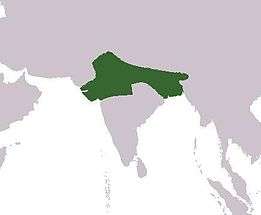Pushyabhuti dynasty
| Pushyabhuti dynasty | ||||||||
| ||||||||
 The Empire of Harsha | ||||||||
| Capital | Thanesar | |||||||
| Government | Monarchy | |||||||
| History | ||||||||
| • | Established | 6th century | ||||||
| • | Disestablished | 7th century | ||||||
| ||||||||
The Pushyabhuti dynasty (IAST: Puṣyabhūti), also known as the Vardhana dynasty, ruled parts of northern India during 6th and 7th centuries. The dynasty reached its zenith under its last ruler Harsha-Vardhana.
Origins
No concrete information is available about the origins of the dynasty. Harshacharita by the 7th century poet Bana gives a legendary account of their origin, naming Pushyabhuti as the dynasty's founder. According to this legend, Pushyabhuti lived in the Srikantha janapada (modern Kurukshetra district), whose capital was Sthanvishvara (modern Thanesar). A devotee of Shiva, Pushyabhuti became involved in a tantric ritual at a cremation ground, under the influence of Bhairavacharya, a teacher from "the South". At the end of this ritual, a goddess (identified with Lakshmi) anointed him the king and blessed him as the founder of a great dynasty.[1]
The Pushyabhuti mentioned in Bana's account appears to be a fictional character, as he is not mentioned in the dynasty's inscriptions or any other source.[2]
History

The Pushyabhuti dynasty originally ruled a small area around their capital Sthaneshvara (Thanesar). According to Hans T. Bakker, their ruler Aditya-Vardhana (or Aditya-Sena) was probably a feudatory to Sharva-Varman, the Maukhari king of Kannauj. His successor Prabhakara-Vardhana may have also been a feudatory to the Maukhari king Avanti-Varman in his early days. Prabhakara's daughter Rajyashri married Avanti-Varman's son Graha-Varman. As a result of this marriage, Prabhakara's political status increased significantly, and he assumed the imperial title Parama-bhattaraka Maharajadhiraja. ("the one to whom the other kings bow because of his valour and affection").[3]
According to the Harshacharita, after Prabhakara's death, the king of Malava attacked Kannauj, supported by the ruler of Gauda. The Malava king killed Graha-Varman, and captured Rajyashri.[4] Bana does not mention this king, but historians speculate him to be a ruler of the Later Gupta dynasty.[5] Prabhakara's elder son Rajya-Vardhana defeated the Malava ruler, but was treacherously killed by the Gauda king.[6]
The Harshacharita further states that Prabhakara's younger son Harsha-Vardhana then vowed to destroy the Gauda king and their allies. [7] Again, Bana does not mention the name of the Gauda king, but historians identify him with Shashanka-Deva, a Maukhari vassal (mahasamanta). Harsha formed an alliance with Bhaskar Varman, the king of Kamarupa, and forced Shashanka to retreat. Subsequently, in 606 CE, Harsha was formally coronated as an emperor.[8] He captured a large part of northern India (see the Empire of Harsha). He died without an heir, leading to the end of the Pushyabhuti dynasty.[9]
Rulers
The following are the known rulers of the Pushyabhuti or Vardhana dynasty, with estimated period of reign (IAST names in bracket):[10]
- Pushyabhuti (Puṣyabhuti), possibly mythical
- Adityasena (Ādityasena), c. 555-580 CE
- Prabhakara-vardhana (Prabhākaravardhana), c. 580-605 CE
- Rajya-vardhana (Rājyavardhana), c. 605-606 CE
- Harsha-vardhana (Harṣavardhana), c. 606-647 CE
References
- ↑ Hans Bakker 2014, pp. 78-79.
- ↑ Hans Bakker 2014, p. 80.
- ↑ Hans Bakker 2014, p. 79.
- ↑ Hans Bakker 2014, p. 81.
- ↑ Hans Bakker 2014, p. 82.
- ↑ Hans Bakker 2014, pp. 85-86.
- ↑ Hans Bakker 2014, p. 87.
- ↑ Hans Bakker 2014, p. 88.
- ↑ Sukla Das 1990, p. 2.
- ↑ Ronald M. Davidson 2012, pp. 38-39.
Bibliography
- Hans Bakker (2014). The World of the Skandapurāṇa. BRILL. ISBN 978-90-04-27714-4.
- Ronald M. Davidson (2012). Indian Esoteric Buddhism: A Social History of the Tantric Movement. Columbia University Press. ISBN 9780231501026.
- Sukla Das (1990). Crime and Punishment in Ancient India. Abhinav Publications. ISBN 978-81-7017-054-9.